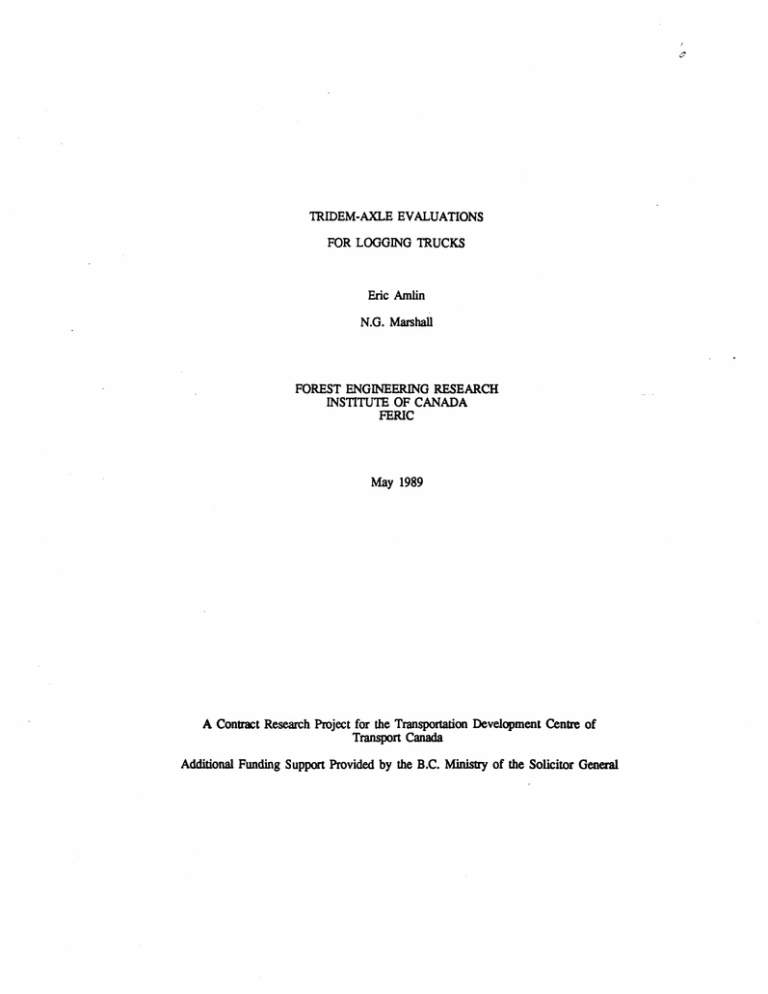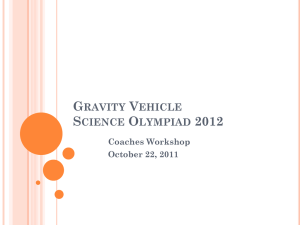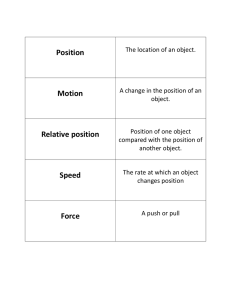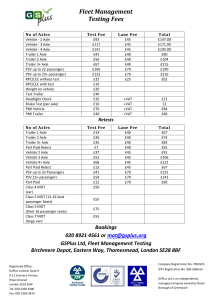TRIDEM-AXLE EVALUATIONS FOR LOGGING TRUCKS Am1in Marshall
advertisement

TRIDEM-AXLE EVALUATIONS FOR LOGGING TRUCKS Eric Am1in N.G. Marshall FOREST ENGINEERING RESEARCH INSTITUTE OF CANADA FERIC May 1989 A Contract Research Project for the Transportation Development Centre of Transpon Canada Additional Funding Suppon Provided by the B.C. Ministry of the Solicitor General ABSTRACT Highway logging-truck opezators in British Columbia have progressively increased the payload of their vehicle combinations by adding trail« axles. This evolution of ttailer capacity has introduced new limitations for conventional tandem drive-we tractors in the areas of off-highway traction, braking effectiveness, and pavement loading. The Forest Engineering Research Institute of Canada (FERIC) recently began a contract study with the Transportation Development Centte (TDC) to evaluate the use of tridem-axle groups on logging-truck tractors. The fllSt phase of this two-phase project was done in cooperation with the National Research Council (NRC) and Vehicle Systems Development Corporation (VS DC). Phase I involved the stability and gradeability modelling of four clUTent tandem-axle logging-ttactor combinations and three potential tridem-axle tractor combilldtions. This paper describes the objectives and scope of the Tridem-Axle Evaluation Project and summarizes the Phase I results to date. INTRODUCTION In order to minimize the increased transportation costs resulting from the timber resource becoming furthez distant from the processing mills, the truck operatOrs in the Interior of British Columbia have been increasing payload capacity of truck/trailez combinations by adding more axles to the trailers. While the payload capacity of the trailers has increased, the ability of the truck to pull the ttailer has not changed, the braking effectiveness and safety of the tractors has been reduced, and the potential for pavement damage from the loads on the tandem drive axles has increased. Efforts to reduce the loading on the drive axles of the tractor by modifying the load configuration have not been successful. Consequently, the trucks continue to operate with tractive effort limitations in the off-highway portion of the haul route, overloading on the drive axles, and reduced braking effectiveness. The We8tem Division of FERIC, in contract with the Transportation Development Centre (TDC) of Transpcxt Canada, has recently begun a research project to address these problems. The objectives of the project are: • To evaluate the stability, traction, and operational productivity of the tridem-axle group recommended by the weights and. dimensions study conducted by RTAC. ' • To improve the braking safety of logging trucks on public highways. • To reduce the risk of damaging the pavement on public highways. • To increase the off-highway tractive ability of logging trucks. Originally, it was thought that using a lridem-axle group with a steering-and-lifting axle would solve tbe problem. However, in FERIC's discussions with transportation engineers it was suggested that a tridem group with all axles powered was also a possible solution. It was proposed that two tractor configurations be considered (Figure I), one being a lridem group consisting of a non-driven steering-and-lifting axle with two driven axles, the othez, a tridem group with all axles driven and non-lifting. NON- DRIVEN AXLE Figure 1. Basic Tridem Options for Study A tridem group sOOuId solve the problems of tractive effort limitations, drive-axle overloading, and reduced braking effectiveness. In the case of the steering-and-lifting axle proposal it is felt that it will overcome the aforementioned problems by adding a steering lift-axle assembly just ahead of the existing tandem drive axles. The lift axle would be in the up position during the return-empty lrip from the mill to the logging site and for the loaded lrip on the gravel or snow-covered off-highway road from the logging site to the public highway. This would permit maximum tractive effort where it is most needed, i.e. on the unpaved offhighway portion of the duty cycle. Prior to operating on the paved highway, the lift axle would be lowezed to create a lridem group with reduced axle loading and increased brake effectiveness. In the case of the all· driven tridem group, it is expected that similar traction benefits will accrue because of better torque lRoads and Transp. Assoc. of Can. t Vehicle Weights and Dimensions Study, Vols. 1-16. distribution across all three axles. Improvements in braking effectiveness and axle loadings would be the same as with the lifting-axle proposal. Although both solutions could solve the problem, the basic research question is whether less powez per axle or more weight per axle will have a greater effect on increasing traction. Other research questions that will be answered by this project are: • How do both proposed axle groups compare in icy or snow-packed driving conditions? • How do both proposed axle groups affect the tractor's turning radius, especially in the tight turns required in the mountainous areas of Western Canada? • How do both proposed axle groups affect the tractor's safety performance in terms of roll-ovC'Z stability, high-speed lane changes, ere? FERIC's ~h plan is organized into two distinct phases. The first segment has three basic components: preparing a literature search and undertaking a hardware search, preparing a ttaction/gradeability algorithm, and developing the dynamic simulation programs to model the unique logging-truck configurations found in British Columbia. An interim repon based on the summation of these components is expected to yield a vehicle design for field evaluations. The second portion of the research plan will involve the procurement and installation of hardware and a subsequent twelve-month demonsttation period. The vehicle(s) will be placed into regular service and operational costs and productivity will be compared against existing log-hauling vehicles having an equivalent number of axles and gross vehicle weight OBJECTIVES OF THE PROJECf The tridem groups recommended by the RTAC weights and dimensions research have not been tested in the mountainous, off-highway/on-highway operating conditions typically experienced by B.C. logging bUCks. FERIC's primary research objectives are to investigate, demonsttate, and evaluate the effectiveness of tridemaxle and suspension combinations that address the industry's aforementioned problems. Interrelated with this are the following objectives: • To improve the braking safety of logging bUcks on public highways and to appraise lnldng performance on icy or snow-packed road surfaces. The braking capacity of the logging tractortrailer combination should be greater than conventional combinations by the addition of the extra axle. • To reduce the risk of damaging pavement on public highways. The load on the ttactor will be disUibuted to four axles rather than three. • To increase the off-highway ttactive ability of logging bUcks. The traction of the powC'Z unit is becoming the limiting factor as operators increase vehicle payload by increasing trailer capacity. PROJECT PHASE I The initial phase of the project plan is comprised of three distinct components: undertaking a literature search and a hardware search, consbUcting a traction/gradeability algorithm, and developing the dynamic simulation program to -account for the unique logging configurations found in British Columbia. Literature Search and Hardware Search A literature search and a hardware search were conducted to detennine the state of drive-axle and suspension technology and the relevance of the technology to the project Both searches revealed that few advancements have been made in the area of tridem drive-axle technology for Class 8 highway vehicles. North American axle manufacturers have built tridem-dri ve systems in the past, but without a balanced torque distribution from axle to axle. This is because they have used a conventional tandem-drive torque divider in the most forward differential which yields a torque distribution of 50% in the first axle, 25% in the second, and 25% in the third. While some imported tri-drive axles address this need, they are designed for a very unique military application and they require the use of "super-single" wide-base tires as well as a specialized fram~ and suspension. The concept of tti-drive systems is at least fifteen years old and is predominantly found in the redi-mix industry. Users report two specific problems: (1) The suspension plays a crucial role in the perfonnance of tti-drives and individual axle spin-out is often experienced on "walking_beam" systems. To overcome this, operators lock the inter-axle differential. (2) The aligning moment generated by the three rear axles creates an under-steer situation that negatively influences vehicle manoeuvring. This magnitude of understeez is a function of weight disttibution and wheel base. Very few available tridem suspensions provide equal axle loading. Tridem walking-beam assemblies are available, but their limited vertical axle travel restricts their application for logging trucks. Air suspensions show the greatest promise for tridem drive-axle application and in some cases can be "stiffened" to enhance vehicle roll stability for this high centre of mass application. The addition of a non-driven third axle in either the pusher or tag location is not new. However, the problem related to bringing this add-on axle into a true load-sharing tridem group with the two driven axles rests with the suspension. Most logging trucks in B.C. use a tandem drive-axle walking-beam suspension. Combining this suspension with an air-lift, add-on, axle suspension does not satisfy the criteria of equalized load sharing (Figure 2). Some pneumatic hardware from Europe holds promise of achieving this, but remains .. to be appraised in terms of this concern. > c= ==r /">' /" / / / / / ,, \ I \ , " ..... '- , _-./ // / ,-..._--,,""'" ? \ I I / / / I \ , ? '....... ...... , _--- -,,/ / / / / I . ? ~~----------------~=v-=.-----------------~~ 24 000 kg Figure 2. Equalized Load-Sharing Concern of an Add-On Air-Suspended Axle Both the non-driven third axle group and the all-driven tridem group influence vehicle steerability through their high aligning moment Self-steer, non-driven, third axles offer one potential solution. With this option however, the numerous surface irregularities typical of off-highway roads present major concerns for dynamic stability. A driver-controlled steerable axle, either driven or non-driven, would provide a more stable alternative. Traction/Gradeability Algorithm One of the main objectives of this project is to produce a vehicle with improved ttactive ability for the offhighway portion of the log-hauling route. Vehicle Systems Development Corporation, experts in the field of terramechanics and vehicle mobility, were contracted to provide a computer simulation model that would predict the traction-limited gradeability of the various B.C. logging-truck configurations. This wOJk was restricted to ice and snow-packed road swfaces as these conditions present the greatest traction cballenge to the equipment The modelling of conventional tandem-drive three-axle tracun was used as the baseline from which to gauge the perfonnance of the tridem options. The modelling results are graphically represented in Figure 3, ranking the equipment options in terms of gradeability. Although the 6 x 6 vehicle is shown to be among the best, it does not address the tridem objectives of the project, i.e. it was included as a reference. 9 -:a """" ~ ~ ~ 6 as CD 1::J as ~ C) 3 n Tandem-Axle Tractor, Tandem-Axle-Drive (4xS) P7] Tridem-Axle Tractor, Tandem-Axle Tractor, ~ Front-and-TandemAxle-Drive (6x6) ~ Tridem-Axle Tractor, ~ Tag Axle Up (4xS) LLJ n rLJ Non-Driven Tag Axle Down (4xS) ~ All-Driven Tridem ~ Group (8xS) • Tridem-Axle Tractor, Front-and-Tandem Axle-Drive, Tag Axle Down (8xS) • H - Jeep In ~ poelIon T - Jeep In traction position Figure 3. Gradeability Comparisons Development of Dynamic Perfonnance Models The compensating reach between the truck ttactor and ttailer (Figure 4) is the typical coupling arrangement for B.C. logging trucks. This unique feature means that existing computer simulation models cannot be used to predict the directional behaviour of any of these vehicles. This required the development of three new mathematical models to examine the ttansient, steady-state, and frequency response characteristics of these bUcks. The rollov« threshold could be detennined by using the previously developed University of Michigan Transportation Research Institute (UMTRI) Static Roll Mode1.2 The National Research Council (NRC) was contracted to do this work through their Vehicle Dynamics Laboratory in Ottawa. 7C.C. MacAdam. Computer based study of the yaw/roll stability of heavy trucks characterized by high centre of gravity, SAB Paper No. 821260, 1982. J.Y. Wong and M. El-Gindy. Computer simulations of heavy vehicle dynamic behaviour, user's guide to the UMTRI models, Technical Report No. 3, Vehicle Weights and Dimensions Study, RTAC, June 1985. A perfonnance ranking of existing vehicle configurations was established by means of the following analytical methods: • Tune histories of response to steering input (in the yaw plane motions)• • Frequeucy response analysis. • Geometrical analysis. • Static rollover threshold analysis. This ranking subsequently was used as the reference from which to compare the tridem tractor proposals. Figure 4. The Compensating Reach with its Sliding Action is a Typical Arrangement Used on B.C. Logging Trucks At the time of writing, the preliminary results indicate that none of the considered tridem configurations would be acceptable in terms of roll stability (Figure 5); this is primarily due 10 the raising of the centre of mass location coincident with increased payloads. It should be noted that the increase ranges from 8 to 19 . cm, depending on trailer type. Figure 6 illustrates the significant influence a vertical change in centte-of-mass location has on the rollover threshold of a three-axle tractor/tandem-axle trailer logging ttuck. C) ".-..,... 'lJ (5 ~ 0 '" Cl) ~ ~ I~ Cl) > .2 a: (5 Tridem (Tag axle down) Tandem • Quadaxle trailer ~ Triaxle trailer Tridem (Tag axle up) ~ Pole trailer Figure S. Influence of Tractor Type on Rollover 1breshold 0; 0.3 "" 1J (5 .ct/) Q) 0.2 ~ .c f- CD > 0.1 .2 (5 a: 0.0 -'--~-~8~%"4-~-~4~%~--"""B"'a~s~e~~+~4~%~~+"'8"%~ line Centre of Mass Height Change (%) Figure 6. Influence of Load Centre of Mass Height on Rollovez Threshold SUMMARY AND RECOMMENDATIONS Results At this time (May 1989), the project is nearing the end of Phase L The preliminary reports from both of the modelling experts balO been received and these have been combined with the hardware search. As a result, three general tridem tractor configurations were identified and analyzed with a variety of applopriate hardware. Table 1 summarizes this first phase in tenns of the three options. As presented in F"181Jre 3 a number of the tractor options did improve the traction performance. However, in termS of safe and acceptable dynamic perfonnance, no tridem-grouped tractor could be identified for the transportation of logs. The modelling results bave clearly identified the need to lower the cenlre of mass of these loaded vehicles, especially in cases where extta payload can be added by increasing the number of axles. Although such research goes beyond the scope of this project, the fundamental configuration changes to accomplish this do present a fonnidabIe challenge. To improve ttaction performance over the existing tandem-drive tractors (4 x 6), driven steering axIes (6 x 6) are available. At least one axle manufacturer has eliminated the need for a transfer case in order to drive the steering axle and this translates into a weight savings for these 6 x 6 units. Further to this, the 10% adverse grades generally encountered do not cause a significant shift in weight from the steering axle such that ttactive ability would be reduced. Table 1. Decision Summary Poa.ible configuratiau Vehicle dynamica Offhighway Hardware CoaIidendaa for PbaIe 11 traction o 0 <a> Roll tlueshold too low <0.25 Very good 0 ca> ca> ca> Roll thre.hold too low <0.25 Good Bxilting hardware doea DOl provide for a lteerable third driven ule oor is there a lridem axle system appropriate with even torque distribution @ ca> <a> 0 Roll threshold too low <0.25 Good Hardware available for a complere lridem air lUapeD.ion to utilfy load eqoa1izatiao; may also be poI.ible to achieve with European valving ()'et to be appraised) for om-driven air-auspended axle in combination with existing walkinabeam auembliea @ Non-driven air lift Tri-drive & oon steering 6 x 8 om-lifting 3rd axle Loading m drivel far exc:eedJ the manufac::torer'. capecitiea for both axle. and mspensiClll when the lift axle is raised l!!2-DyuamicaIly UDItable IDCl ha 1wdware Umitatiaaa No - Hardware DClC MilmIe and is UDJtable No - TbiI ccmbinaIicG Cb. DOl provide good dynamic Itability Conclusions As a result of the low lateral acceleration or rollover threshold values (0.221 to 0.248 g) predicted by the modelling of tridem-axIe group tractors, there is not justification for this project to proceed to the second phase. The swnmary report for Phase I will recommend that no tridem-axle logging tractor be fabricated for Phase 11 testing- SESSION 7 - VEHICLE/PAVEMENT INTERACTION 2 Chairman: Peter Sweatman, Australian Road Research Board Speakers 1. Simulation and Measurement of Dynamic Tyre Forces D.J. Cole,D. Cebon, Cambridge University, England 2. The Equalisation of Truck Bogie Axle Weights C.G.B. Mitchell, I.C.P. Simmons, Transport Road Research Laboratory, England 3. Dynamic Axle Loads and Pavement Response J.T. Christison, Alberta Research Council; J.H.F. Woodrooffe, National Research Council, Canada 4. Determining the Cost of Special Trip Permits as a Function of Road Damage C. Morin, Ministere des Transports du Quebec




